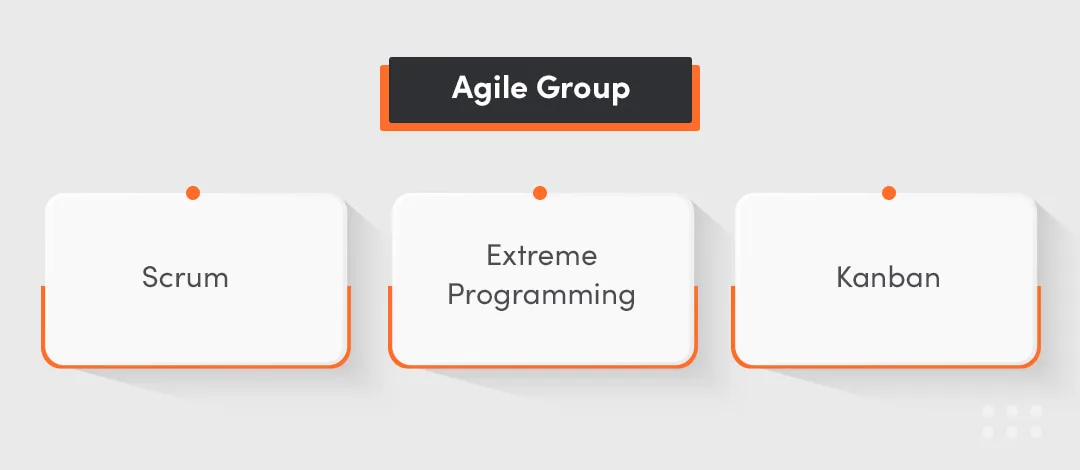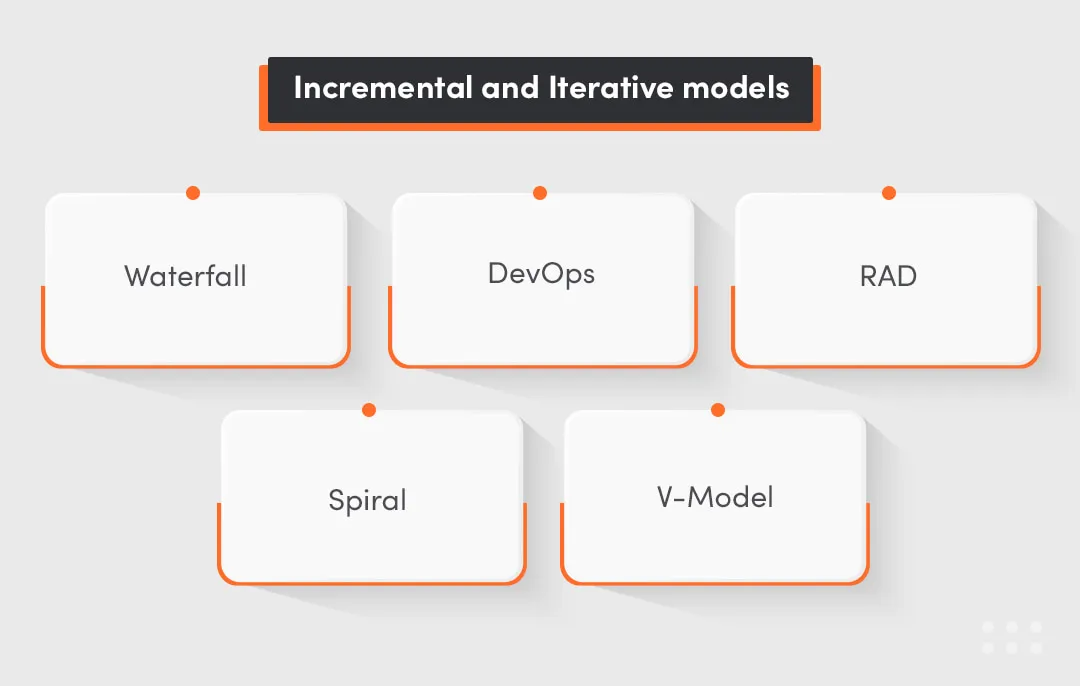The success of your business depends on more than just a great idea - to make sure that you reach your business goal you have to find a strategic alignment between the idea and the right software development model.
A software development model is a structured framework or methodology used to plan, design, create, test, and deploy software applications. It's essentially a blueprint that guides the development process from initial idea to delivery.
The choice of a software development model profoundly impacts various business aspects. It affects timelines, resource allocation, adaptability to change, and, ultimately, the quality of the final product.
Understanding the nuances and benefits of various software development models can significantly enhance your project's success, influencing critical business factors such as project timelines, resource distribution, flexibility in responding to changes, and the overall quality of the software product.
What you will learn from this article:
- How to choose the best software development model?
- The importance of choosing the right software development model
- Types of software development model
- Why is it recommended to use Agile software development
- The industry trends and statistics on software development models
- The impact of software development models on cost, product quality, and time to market.
Why Is It Important to Choose the Right Model?
Choosing the right way to make software is very important because it helps your team work better and faster. It's like picking the best tools and plan for building a house. The better the tools and plan, the quicker and better you build the house.
When you pick a good method, it makes sure everyone knows what to do and when to do it, helps avoid wasting time and money, and makes sure the software you make is really good and what your customers want.
This means your business can do well, keep your customers happy, and stay ahead of others. So, picking the right way to make software is a big deal because it helps your business succeed and grow.

Alignment with Project Goals
Every project comes with unique goals and requirements. Choosing the appropriate framework ensures that your development strategy is in harmony with these objectives, enabling you to concentrate on accomplishing them.
Efficiency and Productivity
The right model enhances workflow efficiency and maximizes productivity. It simplifies communication, allocates tasks effectively, and manages resources efficiently. In essence, the right model fosters cohesive collaboration within software development teams and ensures timely project delivery.
Quality Control
The appropriate model places a strong emphasis on code quality throughout the development lifecycle. It integrates processes for testing, reviews, and feedback loops, allowing you to consistently build high-quality software that aligns with user expectations.
Adaptability and Flexibility
Adaptability and flexibility are crucial in projects, as changes in requirements, scope, or priorities are inevitable. A well-suited model offers the needed flexibility to accommodate these changes smoothly, minimizing disruptions and ensuring project success.
Risk Mitigation and Quality Assurance
Breaking down a project into smaller, manageable units serves as a proactive approach to addressing risks and continuously monitoring and enhancing quality. Adapting and making course corrections throughout the development process reduces the likelihood of major setbacks, thereby improving the overall quality of the final product.
Software development models play a pivotal role in shaping the outcome of a software project, with their influence extending to three crucial aspects - cost, product quality, and time to market. The choice of a development model will determine how resources will be allocated, how the team will collaborate, and ultimately, how successful the project will be.
Cost
The choice of a software development model directly affects project costs. Traditional models like Waterfall often involve extensive planning upfront, potentially leading to higher initial costs. However, they might incur lower costs in later stages due to less need for alterations.
On the other hand, Agile methodologies may seem costlier initially due to their iterative nature, allowing for frequent changes. Yet, they often result in reduced rework costs and offer better cost-effectiveness in the long run. Agile's adaptability minimizes the risk of investing in features that might not align with user needs, optimizing resource allocation and overall expenditure.
Product Quality
Different development models have varying impacts on product quality. Models emphasizing rigorous testing and validation throughout the development cycle, like the V-Model, tend to yield higher-quality software. These models ensure that each phase includes comprehensive testing, reducing the probability of defects and enhancing the final product's reliability.
Models emphasizing continuous feedback loops and iterative development, such as Agile, often result in higher-quality products. The incremental approach allows for constant evaluation and improvement, leading to a more refined and user-centric end product.
Time to Market
The time taken to bring a software product to market is greatly influenced by the chosen development model. Traditional models like Waterfall, with their sequential approach, may have longer development cycles due to extensive planning and documentation required upfront. Changes in requirements often necessitate going back to earlier stages, elongating the time to market.
In contrast, Agile methodologies, with their iterative nature, accelerate time to market. It allows for quicker releases of products to the market as a result of its ability to adapt to changing requirements swiftly and deliver functioning increments of the product in short cycles. Companies employing Agile or similar models can respond promptly to market demands and changes, gaining a competitive edge by launching products faster.
What Are Software Development Models and When to Choose Them?
Software development models play a crucial role in ensuring the smooth execution of software projects. They serve as guiding frameworks for software developers, starting from the initial planning stages all the way through to delivering the final product. Understanding these models is essential when choosing a dedicated development team.
Agile Group

The Agile model relies on small, cross-functional teams that develop usable software through rapid, incremental releases, necessitating expertise and adjustments to project management protocols. In essence, Agile is well-suited for projects with dynamic requirements that demand flexibility.
When to Use Agile?
In large projects, the Agile methodology may incur higher initial costs but holds the potential for long-term cost savings due to its flexibility and adaptability to changes.
For small projects, costs might be higher initially due to continuous involvement and iterations, yet it's ideal for startups or businesses seeking rapid product development and short time-to-market.
Agile is best suited for the development of social media applications like Facebook, Instagram, and X. The iterative nature of agile allows for quick modifications, keeping up with rapidly changing user preferences.
Additionally, platforms such as Amazon, eBay, and Shopify leverage agile principles to continuously enhance user experience, implement new payment methods, and optimize their interfaces.
Agile methodologies can be classified into different types, such as Scrum, Extreme Programming, and Kanban.
Scrum
Scrum is a popular framework within the Agile approach. It divides the development process into short iterations called sprints, typically lasting two to four weeks. Scrum involves specific roles, such as Scrum Master, and Development Team. Daily stand-up meetings, sprint planning, and sprint review sessions are integral to the Scrum framework.
When to Use the Scrum Model
Scrum is best employed when immediate results are needed, amidst ambiguous situations with undefined tasks, or when a client requests a highly tailored development approach for a specific product.
Extreme Programming
In Extreme Programming, a standard iteration typically spans 1-2 weeks. This model permits the introduction of changes even after the iteration has commenced, provided the team has not initiated work on the specific software component. While this flexibility can complicate the delivery of high-quality software, XP addresses this challenge by mandating practices such as pair programming, test-driven development, test automation, continuous integration (CI), small releases, and adhering to coding standards. Additionally, XP advocates for a simple software design to enhance overall development efficiency.
When to Use the Extreme Programming Model
This approach is suitable for scenarios demanding continuous client-developer communication, swift adaptation to change, flexible planning, prioritizing working software, measuring success by meeting client needs and team efforts, and enabling remote project collaboration.
XP model is best suitable for real-time collaboration applications like Google Docs, Trello, or Slack. These apps benefit from XP's emphasis on quick iterations and constant communication.
Additionally, XP's emphasis on testing and adaptability suits the needs of financial trading apps. These platforms require reliability, quick updates, and responsiveness to market changes, making XP an ideal approach.
Kanban
Kanban stands as a prominent framework in agile and DevOps software development, emphasizing real-time capacity communication and full work transparency.
This flexible approach to visual work management adapts to the team's evolving needs. By visualizing work, Kanban enhances comprehension, facilitates showcasing to others, and keeps stakeholders informed. This ensures that the service remains equipped to fulfill the customer's task requirements.
When to Use the Kanban Model
The Kanban Model is appropriate when eliminating unnecessary processes and practices is required, when seeking a model that ensures a smooth flow of the development process, and when the goal is continuous improvement of the system.
Project management platforms like Trello, Asana, or Microsoft Planner are perfect examples of Kanban-style applications. They utilize boards, lists, and cards to visually represent tasks, prioritize work, and manage workflow, aligning with Kanban's principles of visualizing work and limiting WIP (work in progress).
Try our developers.
Free for 2 weeks.
No risk. Just results. Get a feel for our process, speed, and quality — work with our developers for a trial sprint and see why global companies choose Selleo.
Incremental and Iterative Models
Iterative and incremental software development follows a cyclical approach involving regular releases and updates with a gradual incorporation of new features. It starts with planning and progresses through iterative development cycles, incorporating continuous user feedback and adding features incrementally.

When to use the Incremental and Iterative Models
The Incremental and Iterative Model is suitable when there's a need for swift delivery of critical functionality, the project can benefit from new technological innovations, the workgroup is unfamiliar with the domain, or a corporation has ambitious improvement goals.
For example, ERP applications like SAP or Microsoft Dynamics often utilize incremental and iterative development. They can be built module by module, allowing for continuous enhancements and additions while delivering functional components in iterative cycles.
Waterfall Model
This approach involves organizing software development phases to ensure each stage starts after the completion of the previous one.
One of its advantages lies in its suitability for customers who grasp the product's overarching goals. This, in turn, enables the development team to gain a deeper understanding of how the client interacts with the software and the environment in which it must be carried out.
When to Use the Waterfall Model
When applied to large projects, it might initially appear cost-effective due to meticulous upfront planning, but changes during development can lead to increased expenses.
The Waterfall Model is suitable when there is a clear vision of the desired end result, clients cannot modify the project scope once initiated.
For small projects, its rigid structure and lack of flexibility may not be suitable, resulting in high upfront planning requirements that are not typically recommended.
When applied to large projects, it might initially appear cost-effective due to meticulous upfront planning, but changes during development can lead to increased expenses making it less ideal for highly dynamic or innovative projects as a result of its limited adaptability to changing requirements.
DevOps Model
The DevOps model is a collaborative strategy that integrates software development and IT operations. It places a strong emphasis on automation and continuous delivery, empowering teams to swiftly deploy new software features efficiently. This approach encourages cross-functional collaboration and knowledge sharing, fostering a close working relationship between developers and operations teams in building and maintaining software systems. Additionally, it emphasizes the significance of monitoring and feedback, enabling teams to enhance the software system's performance.
When to Use the DevOps Model
The DevOps Model is most fitting for smaller, less intricate projects that demand a high level of expertise. Yet, without proper documentation of requirements, there's a significant risk of failure.
For example, CI/CD applications like Jenkins or GitLab CI/CD are themselves developed using DevOps practices. These tools automate the build, test, and deployment processes, enabling faster and more reliable software releases.
RAD
The Rapid Application Development model is an Agile variant that emphasizes swift prototyping and iterative development. In this approach, a compact, cross-functional team collaborates closely with customers to quickly prototype and test new software features. Ideal for projects with tight deadlines or evolving requirements, RAD is recognized for its rapid development, adaptability, and collaborative nature.
When to Use the RAD Model
While well-suited for small to medium-sized projects, RAD demands skill and meticulous management. Properly handled, it can be effective even for large, complex projects, though there may be potential quality issues.
Applications like Adobe XD, Sketch, or Figma, used for designing user interfaces and prototypes, are developed using RAD principles. These tools allow quick creation, iteration, and testing of designs, aligning with RAD's emphasis on rapid prototyping.
Spiral
The Spiral Model organizes activities in a spiral, prioritizing their execution based on risk analysis.
In each iteration of this model, objectives or alternatives are chosen based on various characteristics, including personal experience, criteria to be satisfied, and system management forms.
The model is represented in two forms - the angular form, focusing on software development within the project, and the radial form, indicating the increase in cost as each iteration takes longer to finish.
When to Use the Spiral Model
Applications requiring stringent security measures, like banking systems, military software, or data encryption tools, can benefit from the Spiral Model. This approach allows for extensive risk analysis and multiple iterations to enhance security features.
It's not typically recommended for smaller projects due to the associated complexity and initial planning needs. However, in complex projects, the Spiral methodology justifies its costs with a risk-centric approach, making it ideal for large-scale, high-risk projects where thorough risk management and validation are crucial.
V-Model
The V-model, also referred to as the four-tier model, is employed across various development processes, particularly in software development.
This model offers quality management techniques and illustrates the interplay between different stages alongside project development phases. Its name is derived from the shape of its structure, resembling the letter V.
When to use the V Model Phase
The V Model Phase is suitable when requirements and objectives are clear, technical resources and experts are readily available, and when developed system failures are acceptable.
Software used in aerospace and defense, including flight control systems, missile guidance software, or radar systems, follows the V Model. It involves comprehensive testing at each stage to ensure accuracy, reliability, and adherence to strict standards.
Agile Software Development Models - Key Thoughts
Agile software development encompasses diverse methodologies, each with its unique approach to iterative, flexible project management. The most prominent types include Scrum, Kanban, Extreme Programming, Lean, and Crystal.
- Scrum operates in short, iterative cycles known as sprints, promoting collaboration within cross-functional teams and adaptability to changing requirements.
- Kanban centers on visualizing workflow and managing tasks to ensure smooth, continuous delivery, allowing flexibility in task prioritization.
- Extreme Programming (XP) focuses on continuous testing, simplicity, and customer involvement to ensure high-quality, adaptable software.
- Lean methodology targets waste reduction, process optimization, and value delivery, aiming for efficiency and customer satisfaction.
- Crystal emphasizes people and interactions over processes and tools, adapting its principles to suit team dynamics and project needs.
Agile Software Development - Why Is It Recommended?
Agile software development has gained widespread popularity for its distinct advantages that cater to the dynamic nature of modern software projects. The following is a concise overview of Agile’s pros and cons.

Advantages of Agile
- Agile's iterative nature allows for quick adjustments to changing requirements, ensuring the end product remains aligned with evolving needs.
- Its emphasis on teamwork and constant communication among team members and stakeholders fosters better collaboration and understanding.
- Agile’s continuous feedback loops with clients ensure the final product meets customer expectations and adapts to their needs effectively.
- By breaking down tasks into smaller iterations, Agile enables faster delivery of functional components, accelerating the overall development process.
- Agile facilitates simultaneous development and delivery in a structured framework.
Disadvantages of Agile
- Rapid iterations might compromise the long-term sustainability, maintainability, or scalability of the software.
- Agile practices might clash with existing corporate cultures, posing challenges in implementation and adoption.
- Agile's emphasis on working software may sideline comprehensive documentation and detailed design, potentially causing issues in the future.
Industry Trends and Statistics on Software Development Models
Traditional project management methods, such as the waterfall methodology and hierarchical team structures, are finding it difficult to keep up with the present rapidly evolving corporate world. These traditional methods are not flexible enough for the constant changes organizations face. For that reason, businesses are recognizing the need for more adaptable approaches, leading to a surge in the adoption of Agile methodologies. The 16th Annual State of Agile Report reveals that 80% of organizations now practice some form of Agile, highlighting its growing popularity.
As remote work becomes increasingly prevalent, the year 2024 is expected to witness a rise in distributed agile development. Organizations will lean on technologies like video conferencing and real-time collaboration tools to enable seamless communication among team members in different time zones.
Scaled Agile and Scrum techniques continue to remain dominant as Agile frameworks with a primary focus on delivering value rapidly and efficiently. Both emphasize the importance of teamwork, effective communication, and a continuous commitment to improvement.
The Scaled Agile Framework (SAFe), especially, is gaining popularity among organizations as it helps them scale Agile practices for greater efficiency, resilience, and collaboration on a larger scale.
Meanwhile, DevOps, the integration of development and operations practices, is on an upward trajectory. A market survey predicts that the DevOps Market size is expected to reach USD 51.18 Billion by 2030, growing at a CAGR of 24.7% from 2023 to 2030. This growth signifies the increasing adoption of DevOps practices aimed at streamlining development and operations processes for better efficiency and collaboration.
Summary
Choosing the right software development model for your business is a big decision. It's like picking the best tool for the job and making sure it fits just right.
In this article, we've explored the different software development models, but one that really stands out in our opinion is Agile. While the various models offer unique advantages, Agile methodologies stand out as a game changer in a software development process.
Businesses benefit from Agile's ability to mitigate risks, deliver value over time, and maintain a close alignment with customer expectations. These benefits eventually boost a company's competitiveness and responsiveness in today's fast-paced business landscape.





